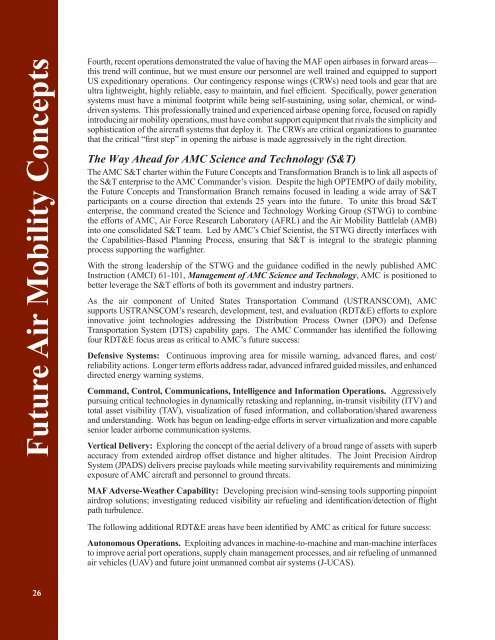Air Mobility Plan, 2008 - The Black Vault
Air Mobility Plan, 2008 - The Black Vault
Air Mobility Plan, 2008 - The Black Vault
Create successful ePaper yourself
Turn your PDF publications into a flip-book with our unique Google optimized e-Paper software.
Future <strong>Air</strong> <strong>Mobility</strong> Concepts<br />
Fourth, recent operations demonstrated the value of having the MAF open airbases in forward areas—<br />
this trend will continue, but we must ensure our personnel are well trained and equipped to support<br />
US expeditionary operations. Our contingency response wings (CRWs) need tools and gear that are<br />
ultra lightweight, highly reliable, easy to maintain, and fuel efficient. Specifically, power generation<br />
systems must have a minimal footprint while being self-sustaining, using solar, chemical, or winddriven<br />
systems. This professionally trained and experienced airbase opening force, focused on rapidly<br />
introducing air mobility operations, must have combat support equipment that rivals the simplicity and<br />
sophistication of the aircraft systems that deploy it. <strong>The</strong> CRWs are critical organizations to guarantee<br />
that the critical “first step” in opening the airbase is made aggressively in the right direction.<br />
<strong>The</strong> Way Ahead for AMC Science and Technology (S&T)<br />
<strong>The</strong> AMC S&T charter within the Future Concepts and Transformation Branch is to link all aspects of<br />
the S&T enterprise to the AMC Commander’s vision. Despite the high OPTEMPO of daily mobility,<br />
the Future Concepts and Transformation Branch remains focused in leading a wide array of S&T<br />
participants on a course direction that extends 25 years into the future. To unite this broad S&T<br />
enterprise, the command created the Science and Technology Working Group (STWG) to combine<br />
the efforts of AMC, <strong>Air</strong> Force Research Laboratory (AFRL) and the <strong>Air</strong> <strong>Mobility</strong> Battlelab (AMB)<br />
into one consolidated S&T team. Led by AMC’s Chief Scientist, the STWG directly interfaces with<br />
the Capabilities-Based <strong>Plan</strong>ning Process, ensuring that S&T is integral to the strategic planning<br />
process supporting the warfighter.<br />
With the strong leadership of the STWG and the guidance codified in the newly published AMC<br />
Instruction (AMCI) 61-101, Management of AMC Science and Technology, AMC is positioned to<br />
better leverage the S&T efforts of both its government and industry partners.<br />
As the air component of United States Transportation Command (USTRANSCOM), AMC<br />
supports USTRANSCOM’s research, development, test, and evaluation (RDT&E) efforts to explore<br />
innovative joint technologies addressing the Distribution Process Owner (DPO) and Defense<br />
Transportation System (DTS) capability gaps. <strong>The</strong> AMC Commander has identified the following<br />
four RDT&E focus areas as critical to AMC’s future success:<br />
Defensive Systems: Continuous improving area for missile warning, advanced flares, and cost/<br />
reliability actions. Longer term efforts address radar, advanced infrared guided missiles, and enhanced<br />
directed energy warning systems.<br />
Command, Control, Communications, Intelligence and Information Operations. Aggressively<br />
pursuing critical technologies in dynamically retasking and replanning, in-transit visibility (ITV) and<br />
total asset visibility (TAV), visualization of fused information, and collaboration/shared awareness<br />
and understanding. Work has begun on leading-edge efforts in server virtualization and more capable<br />
senior leader airborne communication systems.<br />
Vertical Delivery: Exploring the concept of the aerial delivery of a broad range of assets with superb<br />
accuracy from extended airdrop offset distance and higher altitudes. <strong>The</strong> Joint Precision <strong>Air</strong>drop<br />
System (JPADS) delivers precise payloads while meeting survivability requirements and minimizing<br />
exposure of AMC aircraft and personnel to ground threats.<br />
MAF Adverse-Weather Capability: Developing precision wind-sensing tools supporting pinpoint<br />
airdrop solutions; investigating reduced visibility air refueling and identification/detection of flight<br />
path turbulence.<br />
<strong>The</strong> following additional RDT&E areas have been identified by AMC as critical for future success:<br />
Autonomous Operations. Exploiting advances in machine-to-machine and man-machine interfaces<br />
to improve aerial port operations, supply chain management processes, and air refueling of unmanned<br />
air vehicles (UAV) and future joint unmanned combat air systems (J-UCAS).<br />
26
















